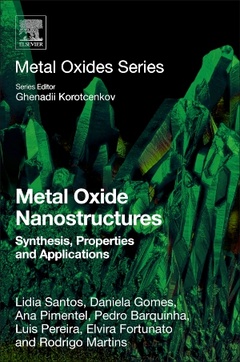Description
Metal Oxide Nanostructures
Synthesis, Properties and Applications
Metal Oxides Series
Authors: Nunes Daniela, Pimentel Ana, Santos Lidia, Barquinha Pedro, Pereira Luis, Fortunato Elvira, Martins Rodrigo
Language: English
Subject for Metal Oxide Nanostructures:
Keywords
<; p>; metal oxide nanostructures; metal oxide nanoparticles; hybrid structures<; /p>
204.32 €
In Print (Delivery period: 14 days).
Add to cart328 p. · 15x22.8 cm · Paperback
Description
/li>Contents
/li>Readership
/li>Biography
/li>Comment
/li>
Metal Oxide Nanostructures: Synthesis, Properties and Applications covers the theoretical and experimental aspects related to design, synthesis, fabrication, processing, structural, morphological, optical and electronic properties on the topic. In addition, it reviews surface functionalization and hybrid materials, focusing on the advantages of these oxide nanostructures. The book concludes with the current and future prospective applications of these materials. Users will find a complete overview of all the important topics related to oxide nanostructures, from the physics of the materials, to its application.
1. Introduction2. Synthesis and design of metal oxide nanostructures3. Structural, morphological, optical and electronic properties of the nanostructures4. Chromogenic applications5. Electronic and sensing applications. Of sensors with interesting performances6. Energy applications7. Hybrid structures and surface functionalization8. Future perspectives
Materials Science research professionals, academics, senior graduate students working on nanostructures, properties and applications.
Her research mainly focuses on electron microscopy and materials characterization. She is co-author of 50 peer-reviewed papers. She participated on the EU project, CEOPS project with the grant agreement no: 309984.
Currently Ana Pimental is working as Post.Doc on the synthesis of ZnO nanoparticles to be used in nanoelectronics.
Her main scientific interests include: Synthes of ZnO nanoparticles by microwave assisted hydrothermal method, on glass and paper based substrates, to be used in different application, such as UV sensors catalysis, platform for SERS applications, piezoelectricity and as an antibacterial agent.
Currently, she is a postdoctoral fellow at CENIMAT|i3N, in the field of electrochromic displays and biosensors, under the European project “Symbiotic with the grant agreement nº 665046 (http://symbiotic-project.eu).
She is co-author of 11 peer-reviewed papers, 1 book chapter and 1 book on this field of research and she presented her work in more than 10 international conferences. Her current research focus areas are: hydrothermal synthesis, nanostructured and nanocrystalline metal oxides, sensors and biosensors, electrochemical displays, memories and transistors.
Pedro Barquinha is an Assistant Professor at the Materials Science Department of FCT-UNL. He is also responsible for 3 research laboratories at CENIMAT focusing on electrical characterization, photolithography and nanofabrication, including the management and operation of a dual-beam SEM-FIB tool.
He has been involved in transparent electronics from 2004, covering all the areas from the design, deposition and characterization of conductive, semiconductive and insulating multicomponent oxides, fabrication and advanced characterization of oxide TFTs, to the intregation of these devices on electroni
- Delves into hybrid structured metal oxides and their promising use in the next generation of electronic devices
- Includes fundamental chapters on synthesis design and the properties of metal oxide nanostructures
- Provides an in-depth overview of novel applications, including chromogenics, electronics and energy




